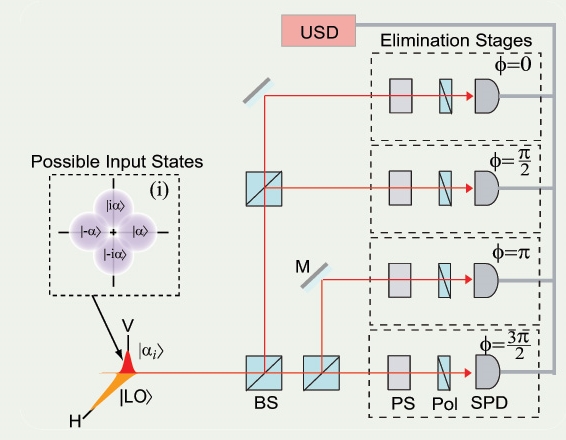June 18, 2013
At low light, cats see better than humans. Electronic detectors do even better, but eventually they too become more prone to errors at very low light. The fundamental probabilistic nature of light makes it impossible to perfectly distinguish light from dark at very low intensity. However, by using quantum mechanics, one can find measurement schemes that can, at least for part of the time, perform measurements which are free of errors, even when the light intensity is very low.
The chief advantage of using such a dilute light beam is to reduce the power requirement. And this in turn means that encrypted data can be sent over longer distances, even up to distant satellites. Low power and high fidelity in reading data is especially important for transmitting and processing quantum information for secure communications and quantum computation. To facilitate this quantum capability you want a detector that sees well in the (almost) dark. Furthermore, in some secure communications applications it is preferable to occasionally avoid making a decision at all rather than to make an error.
A scheme demonstrated at the Joint Quantum Institute does exactly this. The JQI work, carried out in the lab of Alan Migdall and published in the journal Nature Communications, shows how one category of photo-detection system can make highly accurate readings of incoming information at the single-photon level by allowing the detector in some instances not to give a conclusive answer. Sometimes discretion is the better part of valor.
Quantum Morse Code
Most digital data comes into your home or office in the form of pulsed light, usually encoding a stream of zeros and ones, the equivalent of the 19th century Morse code of dots and dashes. A more sophisticated data encoding scheme is one that uses not two but four states---0, 1, 2, 3 instead of the customary 0 and 1. This protocol can be conveniently implemented, for example, by having the four states correspond to four different phases of the light pulse. However, the phase states representing values of 0, 1, 2, and 3 have some overlap, and this produces ambiguity when you try to determine which state you have received. This overlap, which is inherent in the states, means that your measurement system sometimes gives you the wrong answer.
Migdall and his associates recently achieved the lowest error rate yet for a photodetector deciphering such a four-fold phase encoding of information in a light pulse. In fact, the error rate was some 4 times lower than what is possible with conventional measurement techniques. Such low error rates were achieved by implementing measurements for minimum error discrimination, or MED for short. This measurement is deterministic insofar as it always gives an answer, albeit with some chance of being wrong.
By contrast, one can instead perform measurements that are in principle error free by allowing some inconclusive results and giving up the deterministic character of the measurement outcomes. This probabilistic discrimination scheme, based on quantum mechanics, is called unambiguous state discrimination, or USD, and is beyond the capabilities of conventional measurement schemes.
In their latest result (see paper linked below), JQI scientists implement a USD of such four-fold phase-encoded states by performing measurements able to eliminate all but one possible value for the input state---whether 0, 1, 2, or 3. This has the effect of determining the answer perfectly or not at all. Alan Migdall compares the earlier minimum error discrimination approach with the unambiguous state discrimination approach: “The former is a technique that always gets an answer albeit with some probability of being mistaken, while the latter is designed to get answers that in principle are never wrong, but at the expense of sometimes getting an answer that is the equivalent of ‘don't know.’ It’s as your mother said, ‘if you can’t say something good it is better to say nothing at all.’”
With USD you make a series of measurements that rule out each state in turn. Then by process of elimination you figure out which state it must be. However, sometimes you obtain an inconclusive result, for example when your measurements eliminate less than three of the four possibilities for the input state.
The Real World
Measurement systems are not perfect, and ideal USD is not possible. Real-world imperfections produce some errors in the decoded information even in situations where USD appears to work smoothly. The JQI experiment, which implements USD for four quantum states encoded in pulses with average photon numbers of less than one photon, is robust against real-world imperfections. At the end, it performs with much lower errors than what could be achieved by any deterministic measurement, including MED. This advance will be useful for quantum information processing, quantum communications with many states, and fundamental studies of quantum measurements at the low-light level.
Reference Publication
"Implementation of generalized quantum measurements for unambiguous discrimination of multiple non-orthogonal coherent states," F.E. Becerra, J. Fan, A.L. Migdall, Nature Communications, 4, 2028 (2013)













